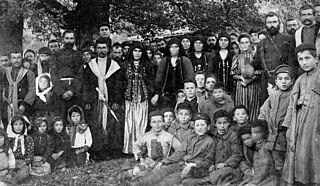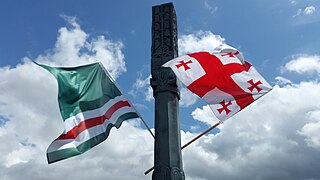
Bats, also known as Batsbi, Batsi, Batsb, Batsaw, or Tsova-Tush) is the endangered language of the Bats people, a North Caucasian minority group living in the Republic of Georgia. Batsbi is part of the Nakh family of Northeast Caucasian languages. It had 2,500 to 3,000 speakers in 1975, with only one dialect. Batsbi is only used for spoken communication, as Bats people tend to use Georgian when writing.

Tusheti is a historic region in northeast Georgia. A mountainous area, it is home to the Tusheti National Park. By the conventional definition of the Europe-Asia boundary as following the watershed of the Greater Caucasus, Tusheti is geographically a European part of Georgia.

The Bats people or the Batsbi are Nakh-speaking Tushetians in the country of Georgia. They are also known as the Ts’ova-Tush (წოვათუშები) after the Ts’ova Gorge in the historic Georgian mountain region of Tusheti. The group should not be confused with the neighbouring Kists – also a Nakh-speaking people who live in the nearby Pankisi Gorge.

Omalo is a principal village in the historical region of Tusheti, Georgia. Administratively, it is part of the Akhmeta District in Kakheti. It lies between the Greater Caucasus Mountain Range and the Pirikita Range of Tusheti. Due to Omalo's high mountain location on the northern slopes of the Greater Caucasus Mountain Range and the absence of well-maintained roads, it is largely isolated from the rest of Georgia for most of the year. The only access road is through the Abano pass at 2,850 metres (9,350 ft) The fortress of Keselo is a landmark in Zemo (upper) Omalo, this place served as a refuge for locals in wartime.

The Kists are a Chechen sub-ethnic group in Georgia. They primarily live in the Pankisi Gorge, in the eastern Georgian region of Kakheti, where there are approximately 5,700 Kist people. The modern Kists are not to be confused with the historical term Kists, an ethnonym of Georgian origin, which was used to refer to the Nakh peoples in the Middle Ages.

Keselo is a small medieval fortress just above the village of Omalo in Tusheti. The site is surrounded by the northern slopes of the Greater Caucasus Mountains. It is bordered to the north and east by Russia, to the east by the Georgian historic provinces Kakheti and to the south by Pshav-Khevsureti. The population of the area is mainly ethnic Georgians called Tush or Tushetians, However, there are some villages nearby which are populated by Daghestanis.
Georgian is a Kartvelian language spoken by about 4 million people, primarily in Georgia but also by indigenous communities in northern Turkey and Azerbaijan, and the diaspora, such as in Russia, Turkey, Iran, Europe, and North America. It is a highly standardized language, with established literary and linguistic norms dating back to the 5th century.

The Museum of Ethnography is a national museum in Budapest, Hungary.

Akhmeta is the administrative – territorial unit in Eastern Georgia, in the region of Kakheti. The administrative center of Akhmeta municipality is the town Akhmeta.

Kazbegi is a district of Georgia, in the region of Mtskheta-Mtianeti in east-north Georgia.

The Tushetians, or Tush, are a subgroup of Georgians who mainly live in Tusheti. Tsova Tushetians speak the Tsova Tushetian language and Chagma Tushetians speak the Chagma Tushetian dialect of Georgian.
The Andi Koysu is a river in Dagestan (Russia) and Georgia. It starts at the confluence of the rivers Pirikiti Alazani and Tushetis Alazani, near Omalo in the Tusheti region of Georgia. It is 144 kilometres (89 mi) long or 192 kilometres (119 mi) including its longest source river, Tushetis Alazani, and its drainage basin covers 4,810 square kilometres (1,860 sq mi). At its confluence with the Avar Koysu, near the village Gimry in central Dagestan, it forms the river Sulak.

The Georgian accordion or Georgian Garmoni is a traditional musical instrument of Georgia. It is especially popular in Tusheti and in Racha. Garmonis can be diatonic or chromatic. This instrument has been modified in the music of different peoples. The result of such adaptation is its variety disseminated in the Caucasus – Caucasian garmoni, Asian garmoni. In the Caucasus garmoni was introduced in the 19th century. The notion Caucasian garmoni is general, as it implies its national varieties, such as: Georgian and Azerbaijani garmonis, Ossetian iron-kandzal-pandir, Adyghean and Kabardyno-Balkarian pshine, Dagestanian komuz. Formation of the Georgian garmoni should have started in the second half of the 19th century. It was made individually in the workshops.

The Tusheti National Park in eastern Georgia is one of the eight new protected areas approved by Parliament of Georgia on 22 April 2003.

Tusheti Strict Nature Reserve is located in the Tusheti Mountainous region in the north-eastern part of Georgia. Visitors center is located in village lower Alvani, Akhmeta Municipality.
Ageurta is a historical village located at the Akhmeta Municipality, in the Kakheti region, Georgia. It is located in the territory of Ajmeta, in the mountainous historical region of Tusheti, 9 km from Omalo.
Chontio is a historical village at the Akhmeta District, in Kakheti, part of the historical region of Tusheti, about 50 kilometers from the town of Omalo, Georgia.

The Tushetian is a breed of small saddle horses native to Tusheti, Georgia. It is probably the result of ancient selection, marked by harsh environmental conditions, under the influence of Arabian and Turkoman horses. Small in size, the Tushetian is known for its resistance, its adaptation to its mountainous region, and its ability to move at the amble gait. Historically, they were mainly ridden for farm work with sheep, and coveted for off-road mountain transport. A rare breed, it is very local and could be threatened with extinction. Protection measures have been recommended in order to preserve it, notably because of its genetic heritage.














